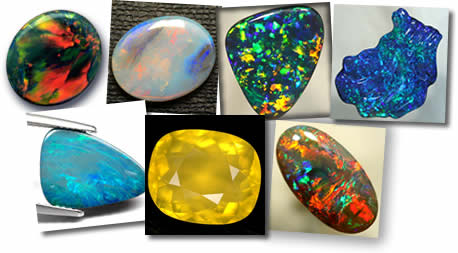Opal: Fire of the Desert

Introduction
On July 27, 1993, opal - a gemstone renowned globally for its brilliant, fiery colors - was proclaimed Australia's national gemstone. This recognition highlights its importance to the country's identity.
Cultural Significance
Australian Aboriginal people believed the opal's colors came from a rainbow touching the earth. Known as the fire of the desert, opal symbolizes Australia's dry interior. Isn't it fascinating how such stories add depth to this gem?
Disclaimer: The beliefs about opal's origins are part of traditional Aboriginal stories and are shared here for cultural context. They are not based on scientific evidence.
Composition and Properties
Opal is a form of silica, chemically similar to quartz, but it includes water in its structure. Precious opal typically holds 6-10% water and features small silica spheres in a regular pattern.
Color Formation
The striking colors appear when light interacts with these spheres. Smaller spheres create blue hues, while larger ones generate red. Red opals can show the full spectrum. The color you see depends on the light's angle, and it might shift or vanish as you turn the gem.
Advantages of Australian Opals
Australian opals are stable and vibrant, making them perfect for jewelry. In contrast, opals from volcanic areas in other countries often have higher water content, leading to cracking during cutting, polishing, or in dry environments.
For essential tips on maintaining the stability and brilliance of your opals, check out our guide to caring for opals.
Types of Opal
The finest opals come from Australia. Black opal, the most famous, is mined at Lightning Ridge in New South Wales. It has a dark base with flashes of red, green, blue, violet, magenta, or yellow.
White opals, lighter with vivid colors, are found at White Cliffs in New South Wales and Coober Pedy in South Australia.
Other varieties include fire opal, with a translucent red or orange base, and boulder opal, a form of white opal.
To dive deeper into the varieties and characteristics, explore our comprehensive opal gemstone information page.
Iconic Mining Locations
Coober Pedy, dubbed the opal capital of the world, sits in South Australia's harsh desert. The extreme heat has led residents to build underground homes, shops, and buildings. You might be surprised to hear there are underground churches too, like Saint Peter and Paul's Catholic Church, built collaboratively by the community for all faiths.
Economic Impact
Australia boasts the world's largest opal fields, surpassing all others combined. Recent data shows Australia's precious stones exports, largely opals, reached about $125 million in the financial year ending June 2022. The industry supports communities in South Australia, New South Wales, and Queensland, with notable impacts like $93 million annually in the Walgett region, including direct and indirect effects.
Conclusion
Opal stands out as a spectacular gemstone that can be shaped into appealing and affordable jewelry. That's why the fire of the Australian outback remains popular worldwide.
Frequently Asked Questions
What is opal?
Opal is a gemstone made of silica with water content, known for its colorful play of light.
Why is opal Australia's national gemstone?
It was proclaimed as such on July 27, 1993, due to its cultural and symbolic importance.
How do opals get their colors?
Colors form when light diffracts through tiny silica spheres; size affects the hue, from blue to red.
What are the main types of Australian opal?
They include black opal, white opal, fire opal, and boulder opal.
Where are opals primarily mined in Australia?
Key locations are Lightning Ridge and White Cliffs in New South Wales, and Coober Pedy in South Australia.
What is the economic value of the Australian opal industry?
Precious stones exports, mainly opals, were about $125 million in 2022, supporting regional economies significantly.

